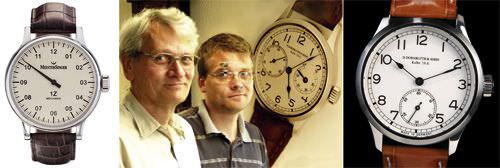
MeisterSinger, Dieter & Dirk Dornblüth, 99.1 by Dornblüth & Sohn
Compared to Scalfaro, the name MeisterSinger sounds very German and it was chosen as a brand name for that reason. Designer Manfred Brassler, living in Münster in North Rhine Westphalia, took a sabbatical after he had sold his former watch company Watch People. In the end, the sabbatical lasted roughly three years but was not only leisure time for Brassler. He was thinking of a new watch, a new brand. He had a special design for his future products in mind. A very clear design, symmetrical, somehow looking the way foreigners sometimes think Germans are. Just finding the right typography for the brand’s name on the dial took him many hours. In the end he came to the conclusion that he liked Arial as his character.
Next step: the hands. “I always wonder how little attention even big brands pay to the development and cultivation of repeating design characteristics,” complains Brassler. “I wanted to create unique hands, ones which were not already in use by any important manufacturer. The solution was too near to be seen. The needle shaped hand of a traditional stop watch fulfilled all of my criteria,” he says.
After the entrepreneur had chosen an English name for his first watch brand, it was important for him to take a German one for his new brand. After another period of hesitation, a friend proposed names like those used for Wagner’s operas. Referring to Meistersinger von Nürnberg, Brassler choose MeisterSinger for his new brand, which was successful right from the start in 2001. Today, the watches have been given several awards by important design centres and seem to be easy to sell. Some 8,000 pieces were sold in 2005 in Germany, Belgium, the Netherlands, Luxemburg, Austria, Switzerland and the Middle East. Partners in Spain and Portugal will start distribution in January 2006. The turnover with the very ‘German watch’ increased 70 percent in 2005. (For further information: www.meistersinger.net)
Are you searching for a watch that looks traditional and has also been made mainly by hand in a very traditional way? Take a trip down to Kalbe, some 60 kilometres north-west of Magdeburg, where Dieter Dornblüth and his son Dirk run their family business. Assisted by five employees, they manufacture big, very clear and sober looking wristwatches with pocket watch movements. The base is the ETA 6497/98 movement of which only the main plate and the moving parts are used. Dornblüth makes the traditional 3/4-bridge, adds screw-in settings for the rubies, making a gearing for a power reserve indicator and a swan neck adjustment. The movement is engraved by hand, gilded and consists of a special construction, made to set the small seconds sub-dial at a proper distance to the hands for the minutes and hours. The special thing about the Dornblüths is that for all these constructions they do not use any modern CNC-automats or similar tooling machines. Instead, they build their watches traditionally with the tools every average watchmaker’s workshop has. It’s easy to understand that with this manner of watchmaking only a small number of pieces can be made. Roughly 120 wristwatches leave the shop per year, sold mostly by direct marketing. Only a few are sold to retailers and customers have to wait at least seven months to get their watches. But that is the same with modern Swiss factories, who have all the modern technical equipment. (For further information: www.dornblueth.com)
Positive Prognosis
The Nuremberg market and consumer research institute GfK – Gesellschaft für Konsumforschung, that makes 2,000 interviews with consumers per month, stated on 27 October 2005: “The mood of the German consumer has improved in October. Looking at the general economic development, as well as their personal financial situation, people are more confident than the month before. The consumer indicator went up from 3.1 to 3.4 in November and people expect a positive development of the business cycle. For the third time compared to the month before, the indicator of the overall expectations looking at the general economical development was better than in the previous month.”
People in eastern part of Germany are more willing to spend money for purchasing consumer products than the people in the western part. This is especially remarkable because the ‘New States’ on the territory of the former GRD have been much more affected by the economic decline.
The conclusion of the GfK-Market researchers is: “The decline has stopped. But this positive trend does not mean that consumer spending will rise constantly.”
TO BE CONTINUED...
In the forthcoming days, the rest of this lenghty survey will be added to our europastar website.
Market Focus Germany: Part 1
Market Focus Germany: Part 2
Market Focus Germany: Part 3
Market Focus Germany: Part 4
Source: December - January 2006 Issue
Click here to subscribe to Europa Star Magazine.








